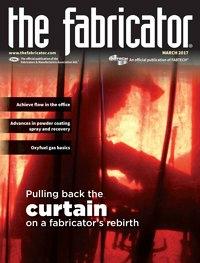Senior Editor
- FMA
- The Fabricator
- FABTECH
- Canadian Metalworking
Categories
- Additive Manufacturing
- Aluminum Welding
- Arc Welding
- Assembly and Joining
- Automation and Robotics
- Bending and Forming
- Consumables
- Cutting and Weld Prep
- Electric Vehicles
- En Español
- Finishing
- Hydroforming
- Laser Cutting
- Laser Welding
- Machining
- Manufacturing Software
- Materials Handling
- Metals/Materials
- Oxyfuel Cutting
- Plasma Cutting
- Power Tools
- Punching and Other Holemaking
- Roll Forming
- Safety
- Sawing
- Shearing
- Shop Management
- Testing and Measuring
- Tube and Pipe Fabrication
- Tube and Pipe Production
- Waterjet Cutting
Industry Directory
Webcasts
Podcasts
FAB 40
Advertise
Subscribe
Account Login
Search
In defense of diversification in metal fabrication
In defense of diversification
- By Tim Heston
- February 24, 2017
- Article
- Shop Management
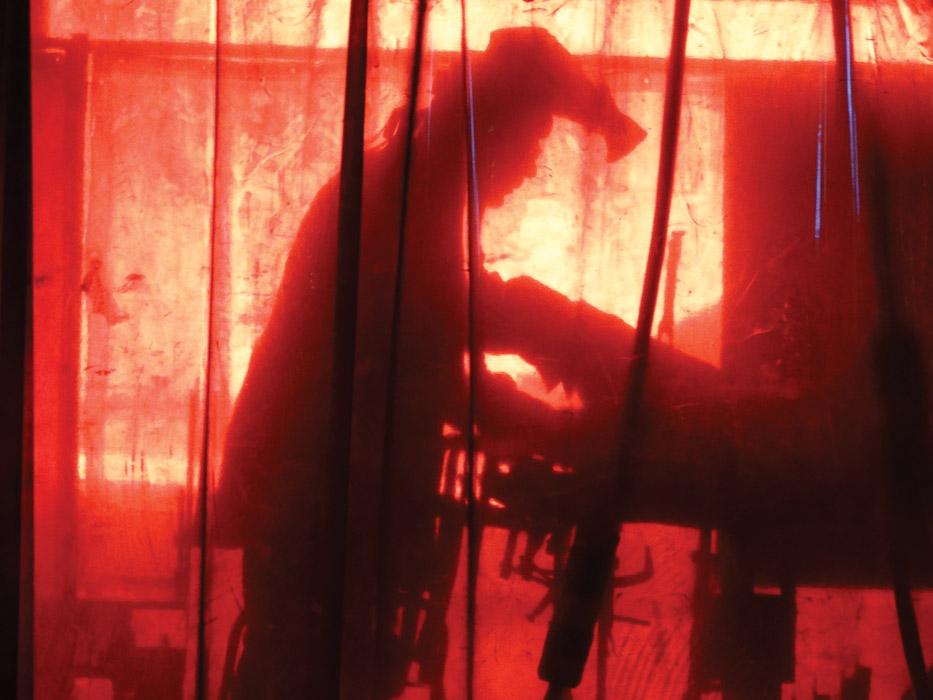
In 2008 welders at Ultra processed armor plate after armor plate. Today they still process a lot of armored plate, but since the UMC acquisition, their projects are much more varied.
In 2008, when I arrived in Shelby, N.C., and pulled into the parking lot of what was then known as Ultra Machine & Fabrication, I saw a truckload of formed and welded armor plate leaving the shipping dock. The truck, carrying the critical underbellies of mine-resistant, ambush-protected (MRAP) vehicles, was headed to Force Protection’s assembly plant near Charleston, S.C. When I left later that afternoon, yet another truck loaded with MRAP underbellies was heading to the same plant.
The place was electric with activity, with 400 employees, including more than 200 welders, working over three shifts in 250,000 square feet of production space. Welding arcs buzzed constantly. Armor plate moved on custom-built fixtures. And a new, high-bay facility behind the main plant had recently opened, housing a 6-kW laser with two gantries traveling over a 200-ft.-long bed. Next to that was a 2,000-ton press brake with an adjustable V die.
The company was planning for a future in which defense work still would make up a significant portion of its revenue, but it wouldn’t be quite as dominant.
You can guess what happened next. The defense work tumbled, and Ultra struggled to regain its footing.
But today the organization is on the rise again, reborn as a very different company. It now has something that managers in 2008 were striving for, before the market pulled the rug out from under them. It has diverse streams of revenue.
The Acquisition
In 2015 Ultra found a buyer, a public holding company called Universal Mfg. Co. (UMC). The holding company also owns Man Lift Mfg. Co., an engineer-to-order manufacturer and modifier of lifts for safety-critical applications. Man Lift now operates in the Shelby plant alongside Ultra, now branded as Ultra Armoring & Defense. The North Carolina operation is also home to UMC’s Metal Works Mfg. Co., which offers custom metal fabrication to various customers.
Today the Ultra operation itself is more diversified. Not only does it fabricate armor plate, but it also modifies SUVs, construction equipment, and other vehicles with armored protection kits, engineered and made to order. Customers include the Departments of State and Homeland Security.
The acquisition helped the Shelby operation reduce its high revenue concentration, a pervasive problem in metal fabrication. In its annual “Financial Ratios & Operational Benchmarking Survey,” published by the Fabricators & Manufacturers Association International®, many fabricators report having just a handful of customers that make up the majority of their revenue. For the past four years, on average fabricators reported having more than half of their revenue coming from just four customers. It’s not an easy problem to overcome, especially for sectors that experience sharp increases in demand, like the oil and gas sector and, of course, the defense business.
The typical story goes something like this: A fabricator grows on the back of a handful of large customers. Success leads to reinvestment: more machinery and people. Their goal is to grow enough excess capacity so that they can sell it to other markets. But they’re also preferred partners with their core customers, who keep sending more work. They also build up a reputation and gain more customers in a particular sector. All of this pumps up the company balance sheet for the short term, yet also drives up revenue concentration. That is, the lion’s share of revenue comes from just a few customers from one or, at best, a few related sectors.
It’s as if fabricators are running on a treadmill and trying their best to keep up with customer demand. They know someone needs to stop running and look for new business outside their core industries. But when the orders keep coming in, that’s easier said than done. Then the orders stop, the treadmill halts, and fabricators are thrown off. Many never climb on the treadmill again.
So how did this North Carolina fabricator climb back on the treadmill? It probably has something to do with the person who founded the Shelby operation.
In the 1980s Frank Stewart worked at C.A. Foy Machine Co., a Kings Mountain, N.C., machine shop, and in 1989 he launched Ultra, which at first specialized in precision machined parts. In 1998 Stewart purchased his first press brake and laser. That first Amada machine now sits facing the company’s behemoth brake, a 2,000-ton LVD model.
“When we had the initial horror stories of our troops facing IEDs, there was a rush from the defense sector. Anyone and everyone who could bend armored plate was now in the defense business,” said Phil Sprio, now president and CEO of Ultra, Man Lift, and Metal Works Mfg. “But Frank was different. He was the second bird to the worm. His company supplied the big guys. The big guys ended up crashing, lessons were learned, and Frank and others on the team did a great job refining the process to hit delivery schedules.”
When the bottom fell out of the defense work, though, Stewart didn’t close up shop. “To his credit, he kept the place open for years,” Sprio said, “mostly writing checks from his pocket.”
By early 2015 the company made an announcement that surprised no one: The plant finally was going to be shuttered. But shortly after that announcement, an acquisition deal was struck. When UMC bought the operation in March 2015, the company kept 80 employees, a skeleton crew compared to the defense-work heydays, for sure, but the plant wasn’t shuttered either. At this writing the head count has increased to 178.
“For a community like Shelby,” Sprio said, “that’s a pretty big deal.”
A New Parent Company
Most significant is that those 150 people aren’t tied solely to one industry. The organization now offers a mix of services that still includes defense work, but also involves several broad markets, many of which aren’t subject to dramatic boom-and-bust cycles.
This includes work for Man Lift, which moved down to North Carolina from Wisconsin after its parent company acquired the Shelby operation. Man Lift makes and modifies lifts used in hazardous and challenging environments in aerospace, oil and gas, industrial manufacturing, and other sectors.
“Now we have less dramatic peaks and valleys in demand,” said Gary Farmer, inside sales manager who was operations manager at Ultra back in 2008. “In the past we had very large, but very few, customers. Ending a large project created a very hard landing for us.”
It’s been a good decade for UMC. According to public filings, UMC’s annual revenue was just $10 million a decade ago; it ended fiscal 2016 with $67 million.
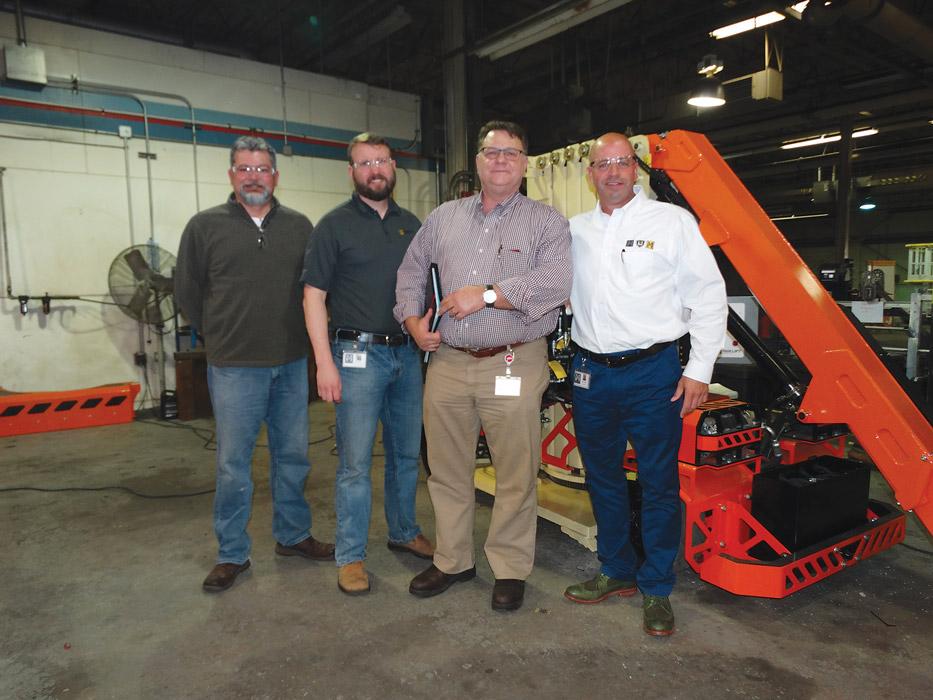
The management team poses in front of a lift being modified for use in extreme environments. From left: Gary Farmer, inside sales manager; Paul Jenson, director, sales and marketing; Mike Matlock, director of operations; and Phil Sprio, president/CEO.
The holding company’s origins go back to World War II, when Ford offered select car dealerships the opportunity to become authorized engine remanufacturers. One of them was Fred Kent, an Iowa car dealer, who started a remanufacturing operation that would eventually become UMC ReTech.
“It’s about as old-school, bench-manufacturing operation you could imagine,” Sprio said. “And they’re still doing great.”
Still, the operation focused entirely on the automotive aftermarket, and in the late 2000s UMC began a quest to diversify. In 2010 it acquired Man Lift, a company that has a broad customer base, and yet still has a strong niche within that market: the need for specialty equipment, such as lifts and industrial carts that are explosion-proof. Most Man Lift products, be it a modification or made from the ground up, are engineered to order. Unlike many other products in the lift business, Man Lift’s products really can’t be viewed as commodities.
“For instance, Boeing buys our equipment for workers who paint their aircraft,” Sprio said. “In a major paint hangar, fumes are explosive, so you can’t use standard equipment.” He added that since UMC purchased it, Man Lift has more than tripled its annual revenue.
Man Lift is also launching customizable product lines. As Sprio explained, “When a company comes to us and requests a unique solution, because there’s no commodity in the market that fills the need, we go to work with our sales and engineering teams, define a solution, and then sell that solution to everyone who is in a similar position in the industry.” One such product is an extension platform that allows workers to access narrow spaces.
Three Brands, One Umbrella
Sprio met Stewart years ago while working in the defense business. Sprio then moved on and did consulting work for Skyjack, a scissor lift maker; from there he made the move to Man Lift and UMC. When he was organizing the transition after the acquisition, Sprio had an idea: Why not move Man Lift down to North Carolina, grow the defense business under the Ultra Armoring & Defense brand, and then grow the commercial contract fabrication side under a new brand, Metal Works Mfg. Co.?
The company now sells this custom fabrication brand by touting its niche capabilities tailored for heavy industry, such as rail, power generation, and construction OEMs. After all, not many fabricators have a 2,000-ton press brake and a laser cutting machine with a 200-ft.-long bed. Metal Works also touts end-to-end services, offering everything from cutting to powder coating under one roof (or two roofs, technically; the painting occurs at the company’s facility in nearby Forest City, N.C).
Most heavy fabrication now occurs in a high-bay facility behind the main plant. And at this writing, most equipment is running between one and three shifts a day, with demand variation spurred by ups and downs in the rail and coal industries.
“And our [Ultra Armoring and Man Lift] brands do not take up all of our fabrication capacity,” Farmer added. “We have a lot of capacity for contract fabrication.”
“The company we inherited was really good at doing a lot of the same thing over and over,” Sprio said. “They were mentally geared that way.”
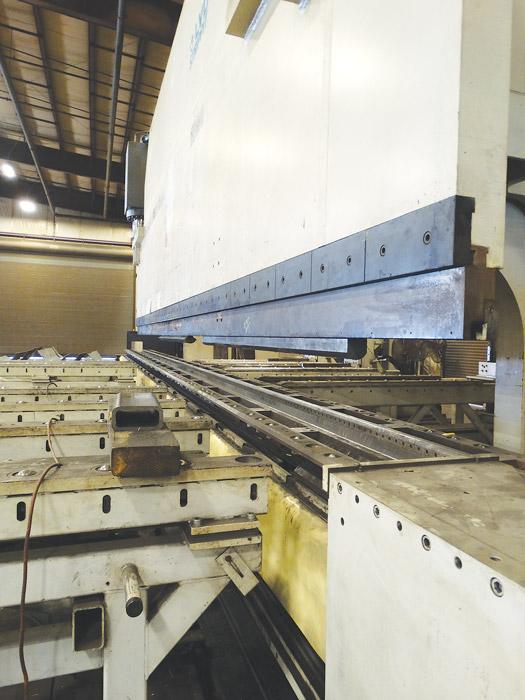
The company’s 2,000-ton press brake has an adjustable V die, which shortens changeover time, which is critical for the company’s high-product-mix environment.
Farmer recalled how workers developed a kind of mobile welding fixture that sped the processing of a specific product family. Today the company still works to streamline flow and increase throughput; for instance, workers now stagger their lunch breaks, a simple change that has increased throughput significantly.
But the company no longer arranges part flow around a specific product because the mix is just too diverse. Some custom fabrication jobs are turned around in days or weeks, while some defense or lift projects, which require more time for engineering and component sourcing, may have a build cycle of three months or longer.
“We’re doing shorter runs of products that are continually evolving,” Sprio said, adding that the operation has become a hybrid: two-thirds of it deals with large, long-term, project-based work; one-third is quick-turn custom fabrication.
“We live in both worlds. And operationally, it can be a challenge,” Sprio said. “All the same, from a systemwide level, our work mix is not as dissimilar as it sounds.” Overall, the manufacturing operation is set up to be a build-to-print operation, be it a commercial fabrication, defense product, or a lift manufacturing or modification project.
The greatest change, he said, has been in engineering and sales. Prior to the acquisition, Man Lift engineers in Milwaukee would walk out to the shop floor and work directly with the people building the product. “The problem is, that model doesn’t scale very well,” Sprio said. “So now we do a lot more engineering on the front end.”
Sales and engineering cycles—the time between when a sale is made and the job is released to the floor—are also vastly different among the different company divisions. An order for Ultra or Man Lift may have a cycle of three months to a year. Metal Works, operating in the custom fabrication world, receives jobs that are released to the floor within days.
Sprio described UMC’s strategic plan as three legs of a stool. The first two legs, Man Lift and Ultra, involve a lot of engineering and planning, which in turn can provide a good margin, but they still can be cyclical. Sprio called them “lumpy businesses.” These have long order-to-ship cycles that require significant upfront investment, so customer payments aren’t as frequent as they are with, say, a blanket order in custom fabrication. “And so that is the third leg of the stool. We got serious about contract manufacturing.”
Talent and Technology
Why did Universal purchase a struggling defense fabricator anyway? After all, when it comes to acquisitions, high revenue concentration, which Ultra most certainly suffered from, usually is a big sticking point.
Sprio explained that the acquisition worked strategically; the companies are more diversified together than alone. And defense work continues to be important. “Defense is a long-term play for us,” he said. “The work isn’t gone. We just needed to find different ways to play in defense. Money isn’t just falling from the sky anymore because everyone is turning out armor.” He added that Ultra has added six new defense clients since 2015, and most of that work involves much more engineering and planning than the traditional build-to-print work of armor plate fabrication.
The engineering and assembly knowledge (including some complex electromechanical assembly) from those on the Man Lift team also helps the defense and custom fab work, Sprio said. The only team members that remain dedicated to specific brands are in sales.
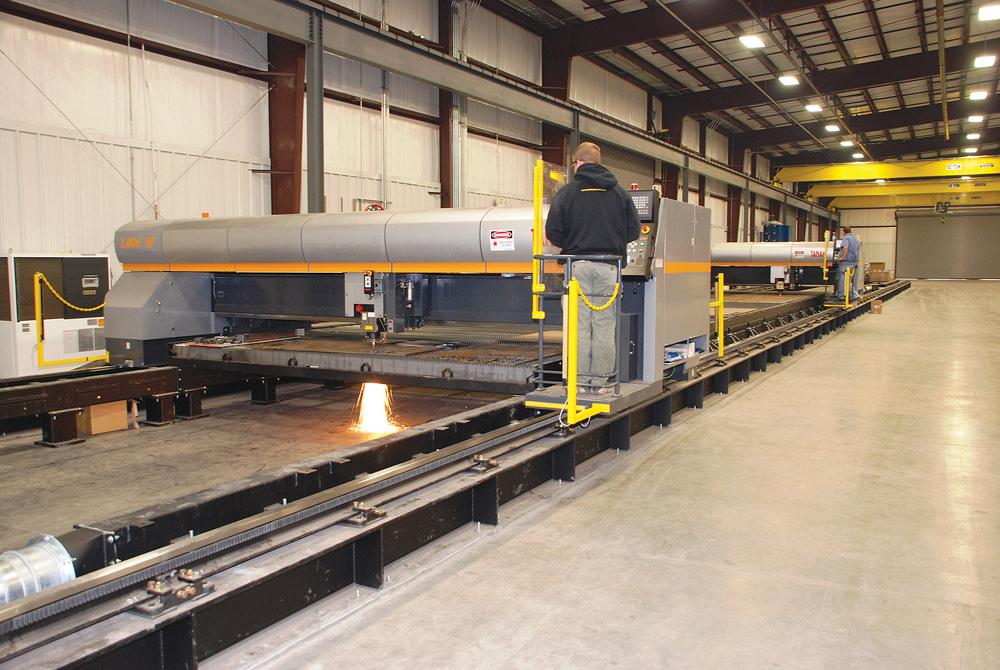
The company’s 6-kW CO2 laser cutting system from Tanaka has two cutting gantries that travel over a 200-foot-long bed. Photo courtesy of Metal Works Mfg. Co.
Moreover, Ultra has certain similarities to Man Lift. Their mission is the same: to keep the people using the product, many of whom work in extreme environments, safe.
For UMC, what set Ultra apart from other defense fabricators? First, Sprio saw that Stewart took care of his employees, and not just by pouring in his own money to keep the facility open. For instance, the plant still employs a part-time nurse practi–tioner whom workers can visit for minor ailments.
Ultimately, Sprio said, it was the people, the culture, and the equipment. Stewart was always aggressive when it came to hiring talent and investing in manufacturing technology. After a very rocky ride, his strategy apparently paid off.
Man Lift Mfg. Co., 414-486-1760, www.manliftmfg.com
Metal Works Mfg. Co., Ultra Armoring & Defense, 704-482-1399, www.metalworksmfg.com, www.ultraarmoring.com, www.universalmfgco.com
About the Author

Tim Heston
2135 Point Blvd
Elgin, IL 60123
815-381-1314
Tim Heston, The Fabricator's senior editor, has covered the metal fabrication industry since 1998, starting his career at the American Welding Society's Welding Journal. Since then he has covered the full range of metal fabrication processes, from stamping, bending, and cutting to grinding and polishing. He joined The Fabricator's staff in October 2007.
Related Companies
subscribe now

The Fabricator is North America's leading magazine for the metal forming and fabricating industry. The magazine delivers the news, technical articles, and case histories that enable fabricators to do their jobs more efficiently. The Fabricator has served the industry since 1970.
start your free subscription- Stay connected from anywhere

Easily access valuable industry resources now with full access to the digital edition of The Fabricator.

Easily access valuable industry resources now with full access to the digital edition of The Welder.

Easily access valuable industry resources now with full access to the digital edition of The Tube and Pipe Journal.
- Podcasting
- Podcast:
- The Fabricator Podcast
- Published:
- 04/16/2024
- Running Time:
- 63:29
In this episode of The Fabricator Podcast, Caleb Chamberlain, co-founder and CEO of OSH Cut, discusses his company’s...
- Industry Events
16th Annual Safety Conference
- April 30 - May 1, 2024
- Elgin,
Pipe and Tube Conference
- May 21 - 22, 2024
- Omaha, NE
World-Class Roll Forming Workshop
- June 5 - 6, 2024
- Louisville, KY
Advanced Laser Application Workshop
- June 25 - 27, 2024
- Novi, MI

























